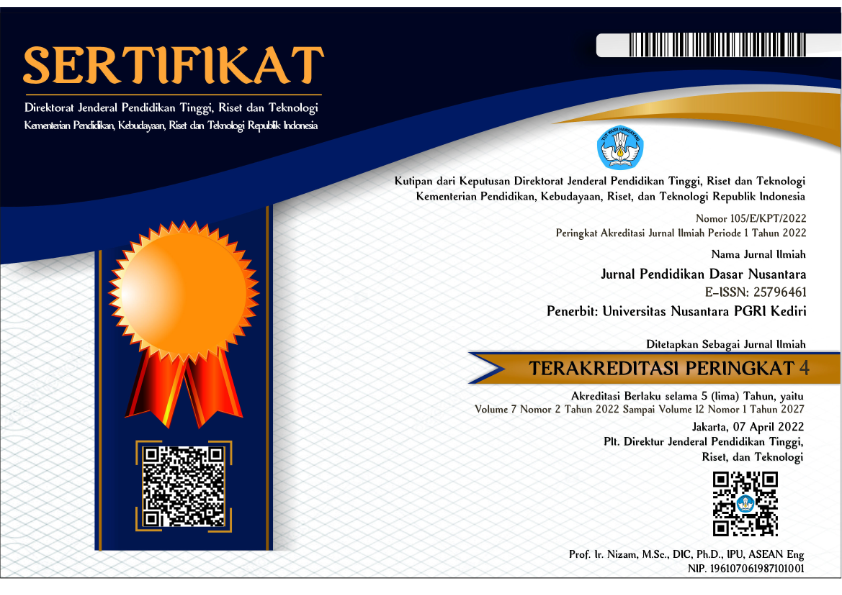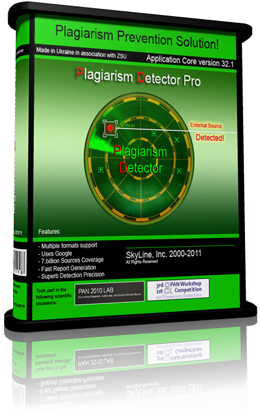Multimedia Interaktif Tipe Adobe Flash CS6 Berbasis Kurikulum 2013 Dalam Meningkatkan Literasi Verbal Siswa Sekolah Dasar
DOI:
https://doi.org/10.29407/jpdn.v6i1.14358Keywords:
Interactive Multimedia Adobe Flash CS6 type, 2013 Curriculum, Verbal LiteracyAbstract
Interactive Multimedia Adobe Flash CS6 is a computer-based interactive learning media that is packaged in a CD (Compact Disk) in which there is an interactive application and also has a menu component that can be clicked on to display certain information in it. This interactive multimedia uses the 2013 curriculum as a guide in packaging interactive learning by increasing the verbal literacy of elementary school students. This research and development aims to (1) Produce a product in the form of interactive multimedia based on learning 2013 using Adobe flas CS6 software. (2) Knowing the feasibility of interactive curriculum-based multimedia 2013. 3) Knowing student responses to interactive learning multimedia type Adobe Flash CS6-based learning curriculum 2013 in improving verbal literacy of elementary school students. This research method uses the Research and Development (R&D) method by adopting the ADDIE model which includes: analysis which is conducting curriculum analysis, needs analysis, material analysis; design includes gathering material and questions, display design, story board, components; development, namely media creation and expert validation; implementation of product trials; Evaluation is a discussion of the product after the trial. The research instrument used was observation, interviews, documentation and questionnaires. The data analysis technique used is descriptive analysis of percentages. Research data from limited field trials amounted to 6 students with a percentage of 83.3% with the category "Valid" to be used by grade II elementary school students as a learning resource. Broader field trials totaling 30 students with a percentage of 92.7% with the category "Very Valid" because by using this multimedia in most active students become a spirit of learning and become more active for use by students in grade II elementary school as learning resources, while the test results verbal literacy students get a percentage of 86.20% with a very good category and add understanding to students to have a high enthusiasm in reading. Suggestions for developing this interactive multimedia product There needs to be training for teachers in making multimedia.
Downloads
References
Akbar, T. N. (2016). Pengembangan Multimedia Interaktif Ipa Berorientasi Guided Inquiry Pada Materi Sistem Pernapasan Manusia Kelas V Sdn Kebonsari 3 Malang. Jurnal Pendidikan: Teori, Penelitian, Dan Pengembangan Volume: 1 Nomor: 6 Bulan Juni Tahun 2016 Halaman: 1120—1126, 1120–1126. Retrieved from EISSN: 2502-471X
Arkűn, S. & Akkoyunlu, B. 2008. A Study on the Development Process of a Multimedia Learning Environment According to the ADDIE Model and Students' Opinions of the Multimedia Learning Environment. Interactive Educational Multimedia University of Barcelona, (17). (Online), (http://www.raco.cat/index.php/iem/article/viewFile/205357/273895), diakses 17 Oktober 2015.
Dalal, M. 2014. Impact of Multimedia Tutorials in a Computer Science Laboratory Course-An Empirical Study.The Electronic Journal of e-Learning, 12 (4). (Online), (http://files.eric.ed.gov/fulltext/EJ1035651 .pdf), diakses 17 Oktober 2015.
Daryanto. 2013. Media Pembelajaran: Peranannya Sangat Penting dalam Mencapai Tujuan Pembelajaran. Yogyakarta: Gava Media.
Dikshit, J., Garg, S., & Panda, S. 2013. Pedagogic Effectiveness of Print, Interactive Multimedia, and Online Resources: A Case Study of Ignou. International Journal of Instruction,6 (2). (Online),(http://files.eric.ed.gov/fulltext/ ED544083.pdf), diakses 1 November 2015
Hartanto, A. (2013). Pembelajaran matematika materi bangun ruang dan balok dengan aplikasi multimedia interaktif di sd negeri teguh sragen, 2(1), 85–89. Retrieved from seruniid.unsa.ac.id
Kurniati. (2016). Modul komunikasi verbal dan non verbal. Modul Komunikasi Verbal dan Non Verbal.
Kusprimanto. 2014. Pengembangan Media Pembelajaran Interaktif Ipa Materi Pencernaan Pada Manusia Untuk Siswa Kelas V Di SDN Pundung, Girirejo, Imogiri, Bantul, Yogyakarta. Skripsi Tidak Diterbitkan. Yogyakarta: Universitas Negeri Yogyakarta
Kurniawati, Rissa Prima 2014. Pembelajaran Berbantuan Multimedia Berdasarkan Cognitive Load Theory Pada Pelajaran Matematika SD. Vol 4. No.1: 79-88.
Lau, N. S. A., Setiawan, D. A., & Werdiningtiyas, R. K. (2019). Literasi Verbal Siswa pada Keterampilan Berbicara pada Siswa Kelas III di SDN Kebonsari 4 Malang Program Studi Pendidikan Guru SD , Universitas Kanjuruhan Malang, Https://conference.unikama.ac.id/artike/, 3(November), 197–210.
Nurgiyantoro, B., & Suyata, P. (2011). Model Penialian Otentik Pembelajaran Bahasa. LITERA, Volume 10, Nomor 2, Oktober 2011 Universitas Negeri Jogjakarta, Volume 10, 114–125.
Putry, I. F. L., & Agung Listiadi”. (2012). Pengembangan Bahan Ajar Berbasis Multimedia Presentasi Interaktif Pada Materi Jurnal Penyesuaian Perusahaan Dagang Untuk Mendukung Pembelajaran Akuntansi Sma Negeri 1 Gresik. Jurnal Universitas Negeri Surabaya”, Volume 01 , 1–6.
Pribadi, Benny. 2014. Desain dan Pengembangan Program Pelatihan Berbasis Kompetensi Implementasi Model ADDIE. Jakarta: Prenada Media Group.
Resmini, N. 2003. Peningkatan Kompetensi Berbahasa dan Kompetensi Matematika Siswa Sekolah Dasar Melalui Pembelajaran Terpadu Berbasis Masalah. Journal of Chemical Information and Modeling. (1–39). doi: 10.1017/CBO9781107415324.004.
Sadiman. S Arif, Rahardjo, Haryono Anung & Harjito. 2007. Media Pendidikan: Pengertian, Pengembangan dan Pemanfaatannya. Jakarta: Raja Grafindo Persada.
Setiadi, H. (2016). Pelaksanaan Penilaian Pada Kurikulum 2013. Jurnal Penelitian Dan Evaluasi Pendidikan Volume 20, No 2, Desember 2016 (166-178), 20(2). Retrieved from http://journal.uny.ac.id/index.php/jpep
Smaldino, S, Deborah, L. James, D. 2011. Intructional Technology and Media for Learning: Teknologi Pembelajaran dan Media untuk Belajar. Jakarta: Kencana.
Susiana, A., Harningsih, S., & Napitupulu, E. (2014). Penggunaan Multimedia Pembelajaran Interaktif Dan Kreativitas Terhadap Hasil Belajar Teknologi Informasi Dan Komunikasi (Tik). Jurnal Teknologi Informasi & Komunikasi Dalam Pendidikan, 1(1), 24–37.
Sunarti & Nursalim. 2018. Kompetensi Bahasa Anak. Jurnal Ilmiah Pendidikan Bahasa dan Sastra. Vol.4(2), ( 8–19).
Sugiyono, 2015. Metode Penelitian Kuantitatif, Kualitatif dan R&D. Bandung :
Downloads
Published
Issue
Section
License
Authors who publish with this journal agree to the following terms:
- Copyright on any article is retained by the author(s).
- The author grants the journal, the right of first publication with the work simultaneously licensed under a Creative Commons Attribution License that allows others to share the work with an acknowledgment of the work’s authorship and initial publication in this journal.
- Authors are able to enter into separate, additional contractual arrangements for the non-exclusive distribution of the journal’s published version of the work (e.g., post it to an institutional repository or publish it in a book), with an acknowledgment of its initial publication in this journal.
- Authors are permitted and encouraged to post their work online (e.g., in institutional repositories or on their website) prior to and during the submission process, as it can lead to productive exchanges, as well as earlier and greater citation of published work.
- The article and any associated published material is distributed under the Creative Commons Attribution-ShareAlike 4.0 International License

































